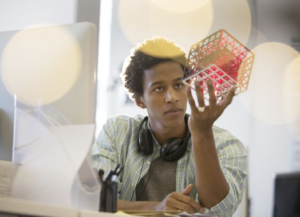 You’ve probably experienced flow at some point––the state of mind where you are completely immersed in an activity, losing sight of anything outside of your work. In The Rise of Superman: Decoding the Science of Ultimate Human Performance, author Steven Kotler writes,
You’ve probably experienced flow at some point––the state of mind where you are completely immersed in an activity, losing sight of anything outside of your work. In The Rise of Superman: Decoding the Science of Ultimate Human Performance, author Steven Kotler writes,
If you’ve ever lost an afternoon to a great conversation or gotten so involved in a work project that all else is forgotten, then you’ve tasted the experience. In flow, we are so focused on the task at hand that everything else falls away.” (pg. viii)
How often do educators (teachers and leaders) experience this as described by Kotler? How about learners inside schools and classrooms? Outside schools and classrooms?
The dominant paradigm of learning––the school-centered paradigm––is focused on dissemination of content knowledge and the filling of learners like vessels. Flow is not a high priority in this paradigm. In addition to a lack of flow experiences, time is filled with noise––tasks such as standardized testing, collecting enough points for a good grade, creation of efficient schedules and keeping the school in compliance with state and federal regulations.
On the other hand, in a learner-centered model where there is focus on real-world problem-identification, designing systems to support the solving of those problems, and the elevation of learner agency and relationships between young and older learners alike, flow is a necessary and critical condition for deep and powerful learning. Learner-centered environments are characterized by focus, not noise.
Interestingly, flow is not turned on and off like a switch. There are four stages:
- Struggle – This can often feel unpleasant because the brain is overloaded with new information and novel situations. Think of it as downloading a new operating system (OS) that will enable you to do new work in a domain more effectively.
- Release – Have you ever had an “aha” moment outside of the learning environment––in the car, in the shower, etc.? This is release. It’s engaging in unrelated activities that allow the new information and novel situations to percolate behind the scenes, making linkages with new and familiar knowledge.
- Flow – This is the state of optimal learning. The body is flooded with performance enhancing and feel-good neuro-chemicals (norepinephrine, dopamine, endorphins, anandamide, and serotonin) that create the experience we call flow.
- Recovery – Like with any strain on body systems, recovery is necessary. This final stage of flow takes time and can be characterized by frustration as we yearn to return to the state of flow..
Learning to better manage struggle and recovery will help us hack flow sequence. But what can we do as leaders to provide the conditions for flow to exist in our teachers, leaders and young learners. Kotler provides some ideas through a list of 17 flow “triggers”:
Psychological Triggers
- Acute attention to focus – on a single task at hand
- Clearly defined goals – break down larger goals into micro-goals/tasks
- Agile, immediate feedback – in the moment, determine what works and what doesn’t, pivoting if needed
- Balance the challenge/skill ratio – ensure that goals are neither too easy (you’ll experience boredom) nor too heard (you’ll over-extend yourself and feel frustration)
Environmental Triggers
- Big consequences – a sense of urgency helps the mind think more clearly
- Rich environment – a work environment/space rich in novelty and complexity
- Deep embodiment – through engaging multi-sensory systems (touch, sight, sound, etc.)
Social/Group Triggers
- Serious concentration – everyone maintains focus
- Shared goals – individual goals are aligned in a group scenario
- Constant communication – provides for that agile, immediate feedback within the group
- Familiarity – everyone in the group is working in the same paradigm; energy is not lost on explanations
- Equal participation and skill sets – everyone is equally in the flow supported by similar levels of skill
- Risk – similar to “big consequences” above
- Sense of control – where autonomy and competence merge
- Close listening – fully engaged in the here and now; avoiding wit and sarcasm that could derail flow
- Always say “yes, and….” – maintain the momentum of flow; “no” will cause flow to dissipate
Creative Trigger
- Creativity – pattern recognition (seeing linkages between new ideas) and risk taking (bringing those new ideas into the world) fueled by novelty
Intrigued? Learn more about flow in this brief introductory talk by Kotler:
Why is flow important in your learning environment? How can you create the conditions for learners to experience flow? What noise is currently occurring in your environment that reduces opportunities for flow?
Connect with Randy on Twitter, the TLTalkRadio podcast, and the Shift Your Paradigm podcast!
Get new content delivered to your inbox and the ebook 3 Key Principles of Digital Transformation. The ebook contains valuable information from my experience leading a digital transformation and working with a variety of stakeholders over the past decade.
- A silver lining - January 22, 2022
- Is our use of tech working against us? 🤔 - September 8, 2021
- What’s NOT going to change in the next 10 years? 🤔 - September 7, 2021